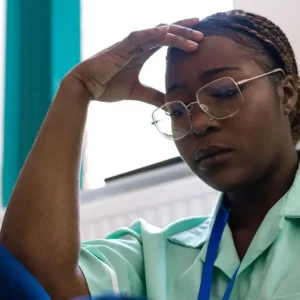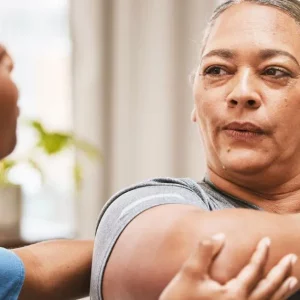Paralysis involves a loss of motor function in the body due to neurological injury. It can affect any number of limbs and manifests differently for everyone. As a result, paralysis treatment works differently for everyone because every neurological injury is unique.
To understand how paralysis treatment works, it helps to have a basic knowledge of the many types of paralysis and the secondary complications that may occur. This guide will explain everything.
Table of contents
Causes of Paralysis
Paralysis is caused by an injury to the nervous system that can happen during a neurological event such as a stroke or spinal cord injury. When the nervous system becomes damaged, signals from the brain cannot appropriately activate muscles required for movement.
Normally, movement is initiated by the brain, where motor signals are sent to the muscles. In order to reach the muscles, motor signals must travel through neural pathways in the spinal cord and peripheral nerves. When neural pathways in the nervous system are damaged, motor signals cannot reach their intended destination and the muscles cannot be activated. When this damage is severe, individuals can experience paralysis.
The amount of movement affected by neurological injury is unique to every person. For example, an individual who sustained a minor stroke may experience weakness in the affected limbs rather than complete paralysis. However, substantial injuries to the nervous system can cause individuals to lose all muscle control in the affected area.
Stroke and spinal cord injury are the two leading causes of paralysis. Other causes of paralysis include:
- Traumatic brain injury
- Cerebral palsy
- Multiple sclerosis
- Bell’s palsy
- Brain cancer
- Brain infection
- Guillain-Barre syndrome
- Seizures
- Amyotrophic lateral sclerosis
- Neurofibromatosis
- Chiari malformation
- Syringomyelia
- Post-polio syndrome
- Friedreich’s ataxia
- Transverse myelitis
- Spina bifida
Depending on which condition occurred, individuals may be more susceptible to paralysis in certain areas of the body. To understand how paralysis is treated, it helps to first understand the different types of paralysis.
Types of Paralysis
When an individual experiences paralysis after a stroke, it most commonly affects the right or left side of their body (hemiplegia). In contrast, most spinal cord injuries result in paralysis on both sides of the body.
The type of paralysis depends upon the type of injury to the nervous system. These different types of paralysis include:
- Monoplegia: paralysis in one limb like the arm or leg.
- Diplegia: paralysis that affects both sides of the body equally, such as both legs. While individuals with diplegia may experience mild motor impairments in the arms, the legs are more severely affected.
- Hemiplegia: paralysis on one side of the body, such as the right arm and right leg. This is most common after a stroke.
- Triplegia: paralysis that affects three limbs.
- Quadriplegia (or tetraplegia): paralysis of all four limbs. The trunk and facial muscles can also be affected. Quadriplegia is often caused by cervical spinal cord injuries and strokes in the brain stem. These types of strokes can lead to locked in syndrome, a condition that involves quadriplegia along with the inability to speak.
- Paraplegia: paralysis of the legs. Following a spinal cord injury, it may also include paralysis of the trunk.
- Facial paralysis: paralysis that affects the face and causes the inability to speak. This is commonly seen in individuals with Bell’s palsy.
Now that you understand how paralysis ranges in severity and affects different areas of the body, the following section will discuss potential complications of living with paralysis. Then we will discuss how paralysis treatment works.
Complications Associated with Paralysis
Paralysis can significantly affect an individual’s mobility and limit their ability to perform everyday activities. Fortunately, individuals can participate in rehabilitative therapies such as physical and occupational therapy to improve their mobility and functional independence. An occupational therapist can also educate you on the various complications that individuals with paralysis have an increased risk of developing.
Potential complications that may develop because of paralysis include:
- Pressure sores refer to skin breakdown caused by placing too much pressure on the same area of the body for prolonged periods.
- Changes in body composition occur as a result of reduced mobility. Individuals with paralysis often experience reduced muscle mass and bone density. Consequently, weight change can also be expected.
- Abnormal muscle tone occurs as a result of disrupted communication between the brain and muscles. Individuals may experience extremely low, flaccid muscle tone or high, spastic muscle tone.
- Chronic pain may occur as a result of abnormal muscle tone placing excess strain on the bones and joints.
- Mental health disorders may occur due to difficulties coping with paralysis.
- Inefficient circulation occurs due to lack of movement. Blood may start to pool in the extremities, which reduces the supply sent back to the heart. This may cause swelling in the arms and legs.
- Poor posture may occur as a result of high muscle tone pulling the body into abnormal positions. Additionally, it can result in low muscle tone, which makes it challenging to sit upright.
- Balance problems may occur due to lack of motor control, which makes it difficult for individuals to maintain their center of gravity. As a result, walking, standing, and sitting may become challenging.
- Bladder and bowel dysfunction occur due to loss of motor control over the bowel and bladder muscles.
- Sexual dysfunction occurs as a result of disrupted communication between the brain and body.
- Respiratory complications occur when control over the major breathing muscles is affected.
Many of these potential complications are related to lack of physical activity. Individuals with severe paralysis may need to hire a caregiver to help reposition and move their bodies from time to time. However, those with milder forms of paralysis may be able to do so themselves.
Making an effort to move around more throughout the day will not only reduce your risk of developing additional complications but also help improve motor control.
Paralysis Treatment

Not all forms of paralysis are permanent. In fact, many individuals with paralysis are able to recover motor control over time. This is possible because the nervous system has the ability to make adaptive changes and reorganize its neural circuitry, known as neuroplasticity.
Neuroplasticity is the mechanism that the nervous system uses to create and rewire neural pathways. Through neuroplasticity, motor functions affected by neurological damage can be rewired to unaffected regions of the brain and/or spinal cord.
Neuroplasticity is triggered by experience. The more you repeat the experience of something, the stronger the neural pathways for that task become. Therefore, motor functions can be strengthened through intensive training of movement.
The most effective way to promote paralysis recovery is to consistently practice moving the affected body parts. Although there are a variety of therapy methods for paralysis that involve moving the body, they all have intensive training in common.
Here are the various paralysis treatment interventions that can help improve your mobility and quality of life:
Physical Therapy
Physical therapy focuses on improving your mobility through targeted exercise. A physical therapist will help guide you through exercises to make sure you’re performing them correctly and safely.
If your paralysis is mild and you’re able to move the affected regions on your own, you should continue to actively practice movement. If your paralysis is complete and you do not have any control over your movements, then have a therapist or trained caregiver move your body for you. This is called passive movement.
Although you’re not actively performing the movement, the movement itself will continue to stimulate the central nervous system. Consistent and repetitive stimulation of the brain and spinal cord help reinforce demand for those functions and promotes neuroplasticity. The more you practice, the greater your chances of recovery.
Occupational Therapy
Occupational therapy helps you develop the skills necessary to perform self-care tasks, return to school or work, and minimize the risk of secondary complications. It involves practicing activities of daily living such as grooming or eating to provide practical, real-world training.
An occupational therapist can also recommend effective ways to compensate for limited movement and develop your functional independence. For example, they may teach you how to use adaptive tools to help you perform everyday activities you may otherwise not be able to on your own.
Speech Therapy
Speech therapy helps individuals with facial paralysis strengthen their oral motor muscles. Paralysis of these muscles can significantly impair an individual’s ability to speak, breathe, chew, and swallow. By practicing speech therapy exercises and activities, individuals can improve their feeding and communication skills.
Individuals with more severe facial paralysis may be taught how to utilize augmentative and alternative communication (AAC) devices such as voice generators to communicate with others.
Mobility Aids
Due to paralysis, individuals may struggle to walk, stand, and sit upright. To compensate for limited mobility, therapists may recommend mobility aids such as wheelchairs, crutches, walkers, and canes. They’ll help you move around, stay balanced, and minimize the risk of falling.
Orthotic Devices
If left unmanaged, spastic muscles can progressively tighten and further restrict your range of motion. Orthotic devices such as braces and splints help provide structural support and resist against abnormal muscle tone. By holding your affected limbs in place, they passively stretch muscles with high tone (spasticity) and help reduce your risk of injury.
Medications
Often, secondary complications of paralysis such as pain, high muscle tone, and depression can interfere with one’s motivation to pursue rehabilitation. Medications may be prescribed to help treat secondary complications. If you believe secondary effects of paralysis are impacting your mental health, speak to your doctor about medications that may help.
Individuals who experience high muscle tone may have very limited range of motion due to severely contracted muscles. To allow you to participate more actively in physical therapy, nerve blockers like Botox injections or muscle relaxants like baclofen may be recommended to temporarily relieve high muscle tone.
Psychotherapy
Individuals who develop mental health disorders such as depression or anxiety and those who are struggling to adapt to life with paralysis may benefit from psychotherapy. This treatment involves identifying what is causing your negative thoughts and behaviors and practicing more effective ways to cope.
Because each individual experiences paralysis differently, paralysis treatment will vary from person to person. What works for one person may not be as effective for another. Therefore, taking a personalized approach to paralysis treatment is ideal.
How Paralysis Is Treated
Many neurological events can cause paralysis, and every neurological event is unique. As a result, there are many types of paralysis that each affect different areas of the body. Fortunately, the nervous system is often capable of healing and rewiring itself through neuroplasticity.
Paralysis treatment often involves activating neuroplasticity through intensive training, while also managing any secondary effects such as pain or spasticity. Work closely with your therapists to assess your unique conditions and build a rehabilitation plan that suits your needs. We hope this article helped you understand how paralysis is treated.

















